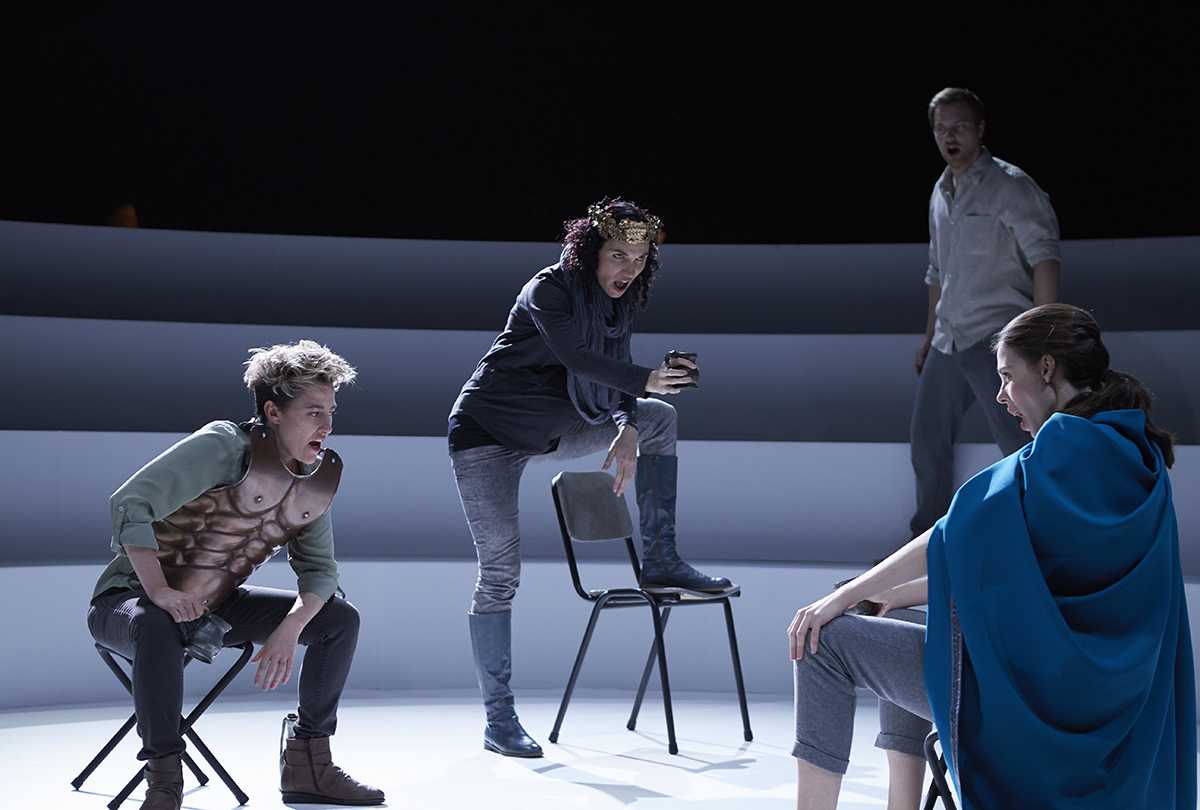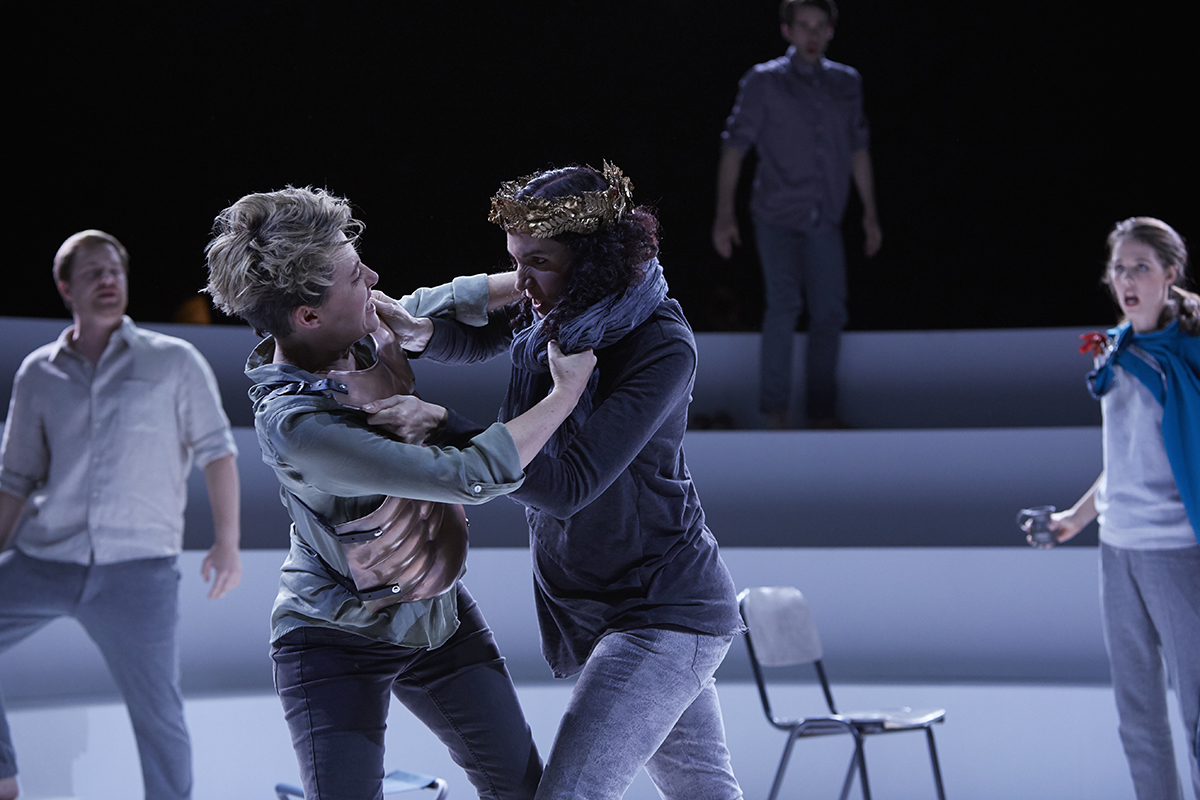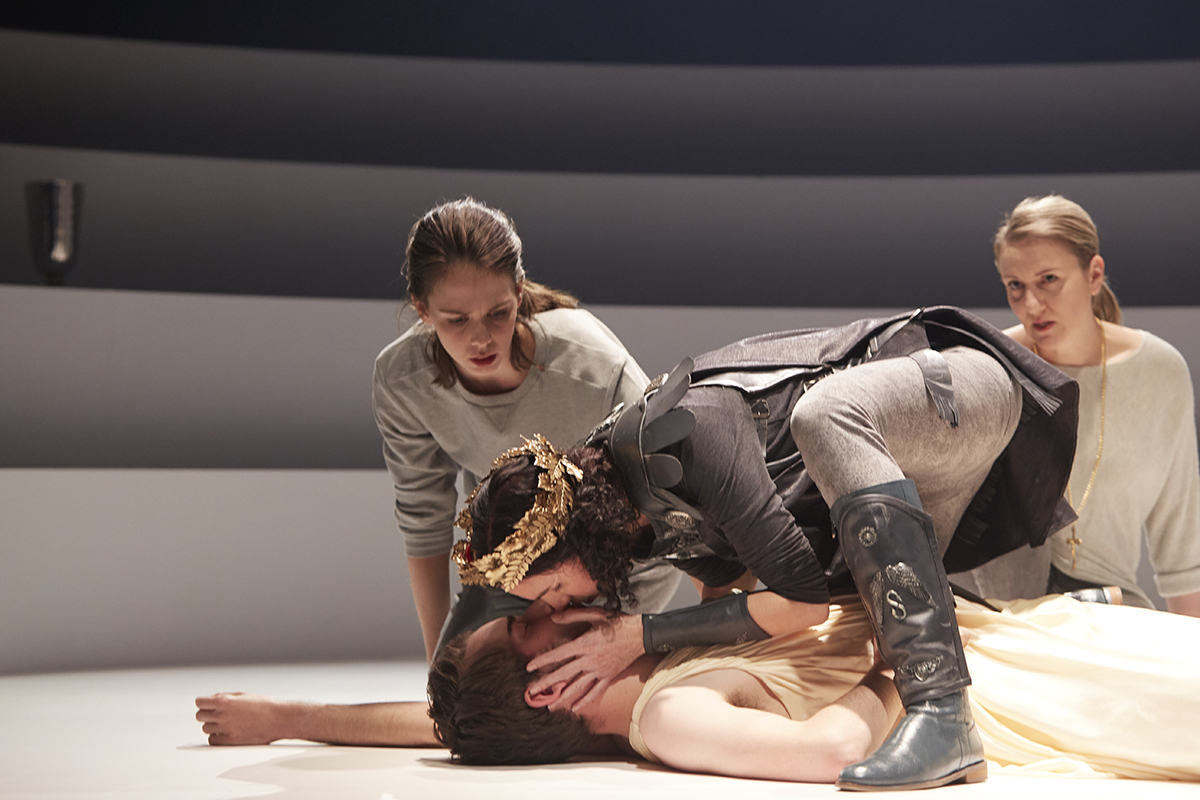
The Rape of Lucretia, put to the test
A brilliant white five-stepped amphitheatre dominates an otherwise deeply dark performance space, the orchestra suspended immediately behind and above. If Britten’s The Rape of Lucretia is a curious melding of Greek Tragedy and mediaeval Catholic morality play, this set inclines to the former but also evokes a space for debate, a symposium in which tensions between pagan and Christian values play out as we attend to the dictums of the opera’s two Christian narrators while witnessing ever evolving psychological tensions.
Sydney Chamber Opera tackles head-on the long acknowledged infelicities of Britten’s opera, an inherent sexism compounded by its Christian narrational framework and a much-debated ambiguity: is the Roman Lucretia raped or seduced by Tarquinius, son of the city’s despotic Etruscan ruler? Directors Kip Williams and Elizabeth Gadsby leave us in no doubt about the latter and overtly subvert the work’s sexism.
Conductor Jack Symonds, singers and chamber ensemble reveal the full range and heft of Britten’s score — gloriously intimate, seductive, martial, probing, emotionally nuanced and grandly impassioned. Authoritatively played and sung, it’s a sublimely cogent listening experience, one that provides a firm foundation for a challenging directorial response to the opera.

L-R Nathan Lay, Jane Sheldon, Jessica O’Donoghue, Jeremy Kleeman, Anna Dowsley, in The Rape of Lucretia, Sydney Chamber Opera, Carriageworks 2017, photo Zan Wimberley
The company’s well-publicised solution to the work’s problems entails a kind of gender role reversal to heighten, for example, our sense of the brutality of the male characters’ drunken sexism. Three casually modern-dressed female performers, lightly attired with props (a crown, a cloak, a breastplate) play the male characters, lip-synching the singers of their roles, who largely hover nearby and sometimes move in parallel with their actors, individually or in carefully choreographed clusters across the amphitheatre.
The men likewise perform the female roles, albeit in relatively elaborate costumes which make much more, possibly too much, of the gender swap, turning gesture into transformation. At its best the device works as intended, underlining the binary absolutes that drive the tragedy and delivering a Brechtian distanciation. There are moments of affecting mime with male bodies expressing heightened vulnerability.
At other times, it’s distracting, the focus on the lip-synching actor lost amid stage movement and variable light levels. At its most potent, largely later in the production, actors’ and singers’ bodies become so closely entwined that there’s an almost Bunraku effect, in which the actors become avatars for their singer-characters or, most affectingly, a melding of genders, for example in the staging of Tarquinius’ assault, the singer Lucretia is as much threatened as the man who is playing her. Finally, the device disappears, giving each key character sole possession of body and voice to bring home the full power of the opera’s closing stages.
The splitting of body and voice makes it difficult for a performer to consistently develop character, especially Lucretia, whose response to Tarquinius and subsequent suicide (a rather literally staged account of the wrenching “Blood washes my shame away”) require a clear emotional through-line. There’s no doubting the acting of the lip-synchers, like Jessica O’Donoghue’s haughty, prowling, sword-wielding Tarquinius or Jeremy Kleeman’s distraught Lucretia, but the discontinuity between the latter and Anna Dowsley’s sung Lucretia when the soprano fully takes the stage is telling, undercutting the full weight of the tragedy. We know the voice, but not the body as Lucretia. The execution of the device is at times brilliantly realised but its effect is only partly revelatory.
The handling of the Male and Female Chorus by the directors implicates them deeply in the drama; they’re not the physically detached commentators Britten insisted on. They move among the other characters, paying not only close attention but sometimes becoming third partners in the physical pairing of the singers and their actors and, if not acknowledged by the others, sharing in the evolving tragedy. But they diverge, the Female Chorus spatially aligning herself with Lucretia, while the Male Chorus, in the production’s boldest stroke, transforms into a mitre-crowned priest conducting a mass, bathed in red light and dominating the amphitheatre.
This directorial strategy corresponds with and underlines the Female Chorus’ potential loss of faith when she sings “Is it all? Is all this suffering in vain?” with passionately existential plangency and conjuring images of ocean, desert and wilderness, in contrast with the Male Chorus’ predictable re-assurance, a blanket hope offered from a position of power but unable to reveal what Christ’s sacrifice and God’s forgiveness have to precisely say about Lucretia’s fate.

L-R Anna Dowsley, Jeremy Kleeman, Jessica O’Donoghue, Celeste Lazarenko in The Rape of Lucretia, Sydney Chamber Opera, Carriageworks 2017, photo Zan Wimberley
Prior to the Female Chorus’ expression of loss, the Romans’ collective shock and grief is expressed with great power by singers and orchestra in the complex weave of the work’s penultimate song, “This dead hand lets fall,” framed by Christian ceremony and the white amphitheatre awash with blood. Their demanding “Is this it all?” declines into a softly resigned “This is all…” which prompts the Female Chorus’ retort, “Is it all?” This is a formidable challenge, which Jack Symonds believes musically represents Britten’s position and which the directors have made visually explicit, countering the Male Chorus’ calm answer, “This is not all” and “He is all,” with an image of all-encompassing Christianity. Within this sits Lucretia, to whom the Female Chorus, refusing to wear the church’s purple, slowly reaches out, dangling her small golden crucifix as if about to drop or, less likely, offer it. It’s an affecting and bold take on Britten’s vision.
By strikingly foregrounding The Rape of Lucretia’s contradictions and inventively resolving them within the logic of the production, largely non-naturalistically but for the most part without loss of feeling, Sydney Chamber Opera has produced a challenging account of the work. Its strength lies in its ensemble playing, musically and theatrically, with singers skilfully responding to the acting demands of non-stereotypical characterisations, lip-synching and complex blocking. Damien Cooper’s subtly graded lighting of David Fleischer’s embracing set amplifies the production’s pyschological nuancing. Jack Symonds believes Britten’s opera more than stands alongside its grand peers. Certainly this production, while in the end veering towards hyperbole, grants the opera an unexpected sense of scale if forgoing organic character evolution, not least for Lucretia.
Anna Dowsley’s singing nevertheless provided lucid aural continuity, from the liquid beauty of “Flowers bring to every year….” (woven with solo oboe) and the near mad fierceness of “Give him this orchid” to the horrified sense of almost numb suspension in lines that poignantly hover between song and speech in “Last night Tarquinius ravished me.” Sydney Chamber Opera’s The Rape of Lucretia is a memorable provocation, made by collaborators determined to free the opera’s greatness of its formal and cultural limitations, quite a task, but an admirable attempt in which the work’s raw power and fine subtleties were frequently felt.
–
Sydney Chamber Opera with Victorian Opera, The Rape of Lucretia, composer Benjamin Britten, musical director Jack Symonds, director Kip Williams, co-director, costume designer Elizabeth Gadsby, performers Anna Dowsley, Nathan Lay, Celeste Lazarenko, Andrew Goodwin, Jeremy Kleeman, Simon Lobelson, Jane Sheldon, Jessica O’Donoghue, set design David Fleischer, lighting design, Damien Cooper; Carriageworks, Sydney, 19, 21, 22, 24, 25, 26 Aug
Top image credit: Jane Sheldon, Jessica O’Donoghue, Nathan Lay and Anna Dowsley in The Rape of Lucretia, Sydney Chamber Opera, Carriageworks 2017, photo Zan Wimberley






